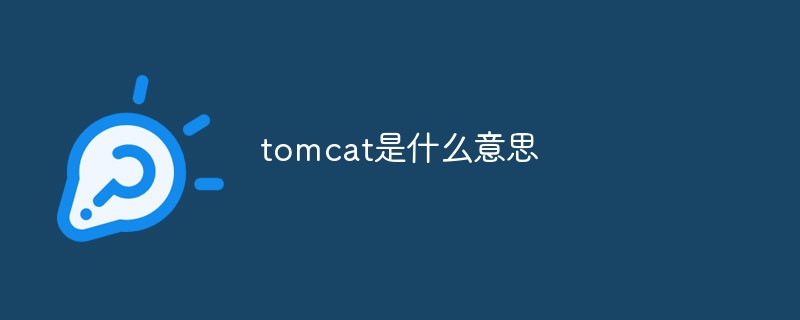
Tomacat is a free and open source Servlet container launched by Apache, which can load JavaWeb programs. Tomcat server is a free open source web application server. It is a lightweight application server. It is commonly used in small and medium-sized systems and situations where there are not many concurrent access users. It is the first choice for developing and debugging JSP programs.

The operating environment of this tutorial: Windows 7 system, Dell G3 computer.
Tomcat: a web server
Tomcat is a free and open source Servlet container launched by Apache, which can load JavaWeb programs , is a necessary environment for configuring JSP (Java Server Page) and JAVA systems. It is a core project in the Jakarta project of the Apache Software Foundation. Because of Tomcat's advanced technology, stable performance and ease of use, it has become the most widely used JSP server.
Tomcat is not just a Servlet container, it also has the function of a traditional Web server: processing Html pages. However, compared with Apache, its ability to handle static Html is slightly inferior.
Tomcat occupies small system resources when running, has good scalability, and supports functions commonly used in development application systems such as load balancing and email services. Therefore, it is deeply loved by Java enthusiasts and has been favored by some software developers. Recognition, like Apache, has long become a mainstream web server.
Tomcat server is a free open source Web application server. It is a lightweight application server. It is commonly used in small and medium-sized systems and situations where there are not many concurrent access users. It is used to develop and debug JSP programs. first choice.
For a beginner, you can think of it this way: when the Apache server is configured on a machine, it can be used to respond to access requests for HTML (an application under the Standard Universal Markup Language) page. In fact, Tomcat is an extension of the Apache server, but it runs independently when running, so when you run tomcat, it actually runs as a separate process from Apache.
Tomcat VS Apache
However, in actual use, Apache and Tomcat have different focuses:
Apache is a Web server, focusing on HTTP Server, but it only supports Html static web pages, but not dynamic web pages such as ASP, PHP, and JSP.
Tomcat is an application (Java) server and can be considered an extension of Apache, but it can run independently of Apache and supports JSP and Servlet.
Apache can connect to Tomcat in one direction and access Tomcat resources, but not vice versa, but they can be integrated on one server.
For example: Apache is a truck, which can hold some things such as HTML, but cannot hold water. To hold water, you must have a container (bucket), and Tomcat is a bucket. (Contains water like Java), and the bucket does not need to be placed on the truck.
Suitable for integrated collaboration and news
As a small and lightweight application server, Tomcat is suitable for small and medium-sized systems and situations where there are not many concurrent access users. It is commonly used under the Internet, but it is not as configurable as Apache, and Apache only supports static web pages. Dynamic web pages such as ASP, PHP, and JS also need Tomcat to process.
Therefore, people usually integrate Apache and Tomcat together: if the client requests a static page, only the Apache server needs to respond to the request; if the client requests a dynamic page, the Tomcat server responds to the request; because JSP interprets code on the server side, so integration can reduce Tomcat's service overhead.
Related recommendations: "Programming Video"
The above is the detailed content of What does tomcat mean. For more information, please follow other related articles on the PHP Chinese website!